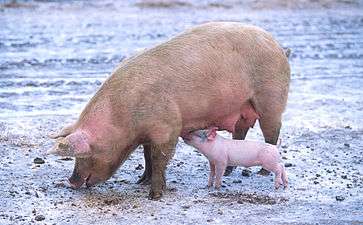Gammon (meat)
Gammon is the hind leg of pork after it has been cured by dry-salting or brining,[1] which may or may not be smoked.[2] Unlike most ham, but like bacon, it must be cooked before it is safe to eat.[2][3] The term is mostly used in Britain, while other dialects of English largely make no distinction between gammon and ham.
.jpg)
Ham hock, gammon hock, or knuckle, is the foot end of the joint, and contains more connective tissue and sinew.[4]
In Britain, joints of cooked gammon are often served at Christmas or on Boxing Day.
The word 'gammon' is derived from the Middle English word for 'ham', gambon, which is attested since the early 15th century and derived from Old North French gambon, itself derived from Old French jambon, which is identical to the modern French word for 'ham'. Old French jambon is attested since the 13th century and is derived from Old French jambe (gambe in Old North French) which in turn is derived from the Late Latin gamba, meaning 'leg/hock of a horse/animal', which can ultimately be traced to Greek kampe meaning 'a bending/a joint', which is from from Proto-Indo-European *kamp- (“to bend; crooked”). In some English dialects a similarly derived 'gambol' refers to a 'leg'.[5][6]
See also
References
- "Gammon recipes - BBC Food". www.bbc.co.uk.
- "Gammon". Wiltshirebacon.com.
- W K H Bode; M J Leto. The Larder Chef. Routledge; 25 June 2012. ISBN 978-1-136-35712-1. p. 178–.
- GOOD HOUSEKEEPING. Gh Food Encyclopedia. Anova Books; 2009. ISBN 978-1-84340-503-0. p. 185–.
- "gammon - Origin and meaning of gammon by Online Etymology Dictionary". www.etymonline.com.
- "gambol - Origin and meaning of gambol by Online Etymology Dictionary". www.etymonline.com.


